Eagle Models: Round 2
Compiled by Martin Willey
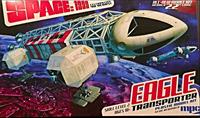
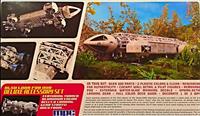

The box has a short endorsement from the SFX director of Space: 1999, Brian Johnson, who originally designed the Eagle.
"It is rare to be a freelance effects technician and achieve success in the film effects industry. Not always a smooth run but I have worked for some amazing Directors and Producers. It is rarer still to find the opportunity to design a lasting icon like the Eagle Transporter from the television production of Space:1999. It was designed with a sense of practical durability and modularity as would be needed for television effects production techniques required of the era. It brings me great joy to know that science fiction fans and modellers stiff hold my design of the Eagle Transporter in such high regard. This model kit from MPC offers everyone the opportunity to build their own Eagle. Its authentic detail demonstrates years of research in documenting the original miniatures used in the show's production. Wouldn't it have been wonderful to have these kits available during filming..." Brian Johnson
These are prototype designs for the Round 2 22 inch Eagle.

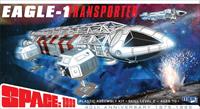
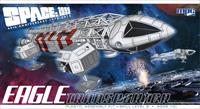
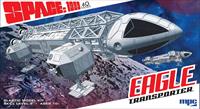
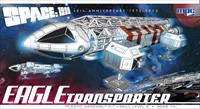


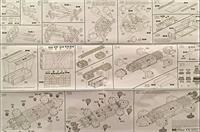
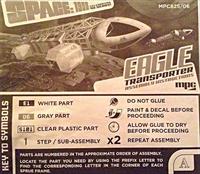
ALPHA BASE, THE EAGLE HAS LANDED!
"Space: 1999", a British television show which first aired on September 4th 1975 was originally to have been a second series of Gerry Anderson's previous 1970 production, "UFO". When that idea was shelved, Brian Johnson, having recently worked on "2001: A Space Odyssey", was hired to supervise the special visual effects (VEX) and miniature work for the new series. Johnson's experience working on "2001" was to prove Invaluable in producing stunning effects sequences rivaling that of the great Kubrick space epic which for the first time portrayed space travel and spacecraft in a realistic and believable fashion. Johnson and his colleague. Nick Allder. adapted what had been learned on "2001" to a television schedule and budget. The resulting efforts were quickly recognized as the very best VFX ever produced for the small screen for many years to come.
DESIGN AND CONSTRUCTION
The Eagle Transporter was named after the first spacecraft to land a human being on the moon in 1969 and the main vehicle used by the "Alphans" throughout both seasons of the show. Johnson, not wanting it to bear resemblance to the craft seen in "2001". based the look of the ship on that of a grasshopper as well as drawing on the inspiration he received from observing the tubular framework present on racing cars. The resulting insect-like configuration of the ship, with its modular components, beefed up landing gear to handle lunar terrain, bell-mouthed long range engines, reaction control thrusters and VTOL jets, represented a very plausible configuration for a lunar based shuttlecraft,
The filming miniatures were built in four sizes, The largest, measuring 43 1/4" long (commonly referred to as 44") was built to 1/24th scale. That scale was chosen for several reasons. First, it's a standard VFX scale which was generally considered the smallest workable scale that can be used for such a craft when it needs to interact with various environments convincingly and hold reasonable depth of field for realistic photography. Another reason is the fact that there were already so many off-the-shelf products available in that scale for environmental depiction, such as the ladders, staircases and other scale enhancing clues from industrial model supply houses like Engineering Model Associates, known more commonly as Plastruct today. Those same products are also made in 1/48th scale, which worked out with the 22" model as well.
The first set of models for the show were reportedly built by Arthur "Wag" Evans of "Space Models", a British based industrial model making company who had also done work on "2001" as well as other Gerry Anderson productions such as "Thunderbirds". Eventually, three 44" models were made, all of them slightly different in detailing as they were built at different times during production (the second model came a little later in the first season, the third 44" model by Derek Freeborn for the second season). The sharp-eyed viewer can tell which model was used in which shot based on the detailing differences, mainly on the shoulder (landing gear) pods. The other sizes made were 22" (1/48th scale), 1l" (1/16th) and 5 1/2" (1/192nd) respectively.
The models were built from a multitude of materials including soldered brass frames, plexiglass (or "perspex" as it is called in the UK) passenger pod and nosecone, solid wood shoulder pods clad in plexiglass and beautifully machined aluminum engine bells. Parts from plastic model kits, primarily the popular 1/24th scale Gemini capsule and the 1/144th Saturn V rocket kits, were used to add surface detailing to the skin along with paneling made from sheet plastic, Bottles of freon propellant connected to hidden tubes were installed inside the passenger pod and activated by an electrical solenoid on cue to allow the appearance of rocket nozzle exhausts to emanate from the ship and stir up dust when taking off and landing.
It is reported that the 44" model, weighing in at nearly 35 pounds and cost about £2,OOO to construct (that's equivalent to over £15,500 or just over $24,000 USD today!), was so robust that the builder stood on tap of it to show off its strength. The models had to be durable to withstand the rigors of daily filming. as the scripts often called for various crash scenes and the models were just too expensive to wreck! Often some breakaway parts like the landing gear were substituted on the models for crash sequences.
The miniatures were originally sprayed in white primer when delivered to the studio and were further dressed by the VFX crew, It is important to note that the models changed somewhat in their appearance as the show progressed. They were very often redressed. repaired and repainted. sometimes significantly altering the way they looked. Thus their appearance changed from episode to episode. shot to shot.
CINEMATOGRAPHY
Filming of the models was done at Bray Studios, miles away from the principle filming at Pinewood, Photography was done long before the advent of even basic motion control technology, The Eagle's take off and landing shots as well as crash scenes were usually done conventionally by suspending the heavy models on thin wires.
Shots of the ships flying in space utilized several methods, the mast common was to mount the models on stationary stands covered in black velvet Or similar material and photographing them against a black background. When the Eagle was suitably lit, the dolly mounted camera was towed past the model imparting movement and direction. By using multiple exposures and adjusting the position of the model relative to the camera, several Eagles could be made to appear flying in formation just by using the one ship. Further exposures allowed the crew to add planets and stars to the scene as required by the script.
Each size of the scale models used were dependent on the type of shot to be filmed. The larger models were to be seen in relative close-up and the smaller models for when the ship was to be seen at a distance. Scenes of the Eagles being destroyed were either achieved optically. using deft editing cuts or by blowing up photographic cutouts.
YOUR KIT
This MPC model kit represents the first "hero" 44" model that was used extensively throughout the series and most well known publicity shots. Given that the original models were redressed so often, this kit was designed to most closely match the original studio model as it was seen in the earlier publicity photos and the first few episodes of Season 1. If the builder of this kit were to be perfectly accurate, he would have to choose a specific shot from the original material and try to replicate it exactly. Which may be impossible given the limited resources available after 40 years. Thus some small compromises were made in the development of this depiction of the studio miniature. It is exactly half the size of the original miniature at 1/48th scale.
Extensive research was done by British film industry modelmaker Chris Trice who had the enviable opportunity to access the original model over many years to take careful measurements from and thoroughly document every part and detail with exceptional accuracy. This research allowed the development of drawings and an accurate CC model by CAD professional Daniel Prud'homme. These assets were used to make this kit as accurate as possible. The command module (nosecone) was scanned directly from a perfected replica made by Chris Trice himself, The pilot figures included in the kit replicate the "Gemini" capsule figures as used in the original miniatures for added authenticity!
We hope you enjoy building this beautiful replica of a very special and iconic design, one of the most accurate model kits of a Science Fiction subject ever produced!
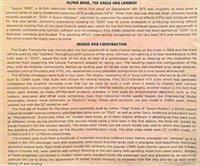
The instructions contains a short introduction to the Eagle and its history. There are a couple of small inaccuracies. Space Models did not work on either Thunderbirds or 2001- that was their rival company, Mastermodels. Many people at Space Models had previously worked for Mastermodels and worked on those productions, but the company did not. Secondly, Wag Evans was a director of Space Models, and the actual model makers were Gary Dickens, David Seymour and John Phillips.
The use of the term "VFX" is odd- Johnson was credited for "SFX", and the term "VFX" was never used. "VFX" now indicates digital effects, while "SFX" refers to practical effects.

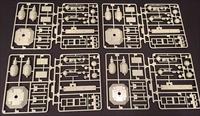


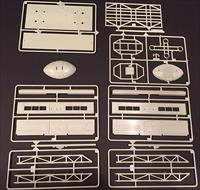

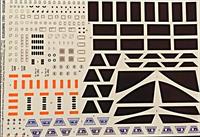

L-R: Todd Morton, Jamie Hood of Round 2, Gordon Moriguchi, Jim Small (model designer) and Donald Hayunga
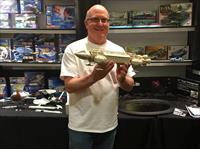
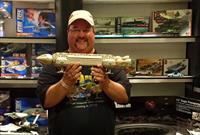
Thanks to Gordon Moriguchi and Todd Morton.
Copyright Martin Willey. Thanks to Gordon Moriguchi.